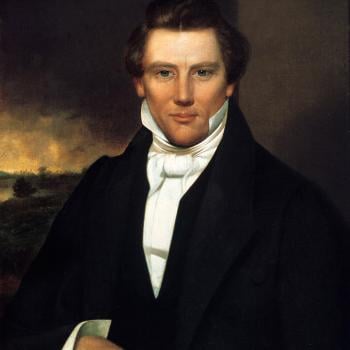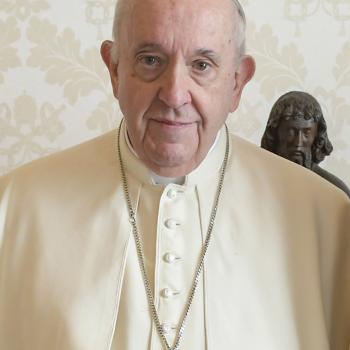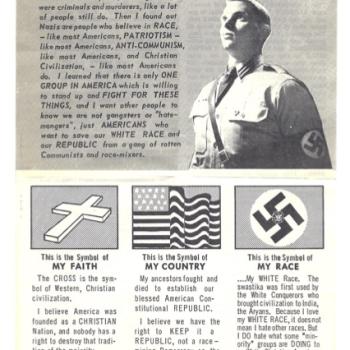PBS recently aired an American Experience documentary about the life of Billy Graham.
 The subject of Graham is a tender one for me. I attended two Billy Graham crusades, one as a high school student in Rochester, New York, one as a seminarian in Louisville, Kentucky. At the first, Graham’s invitation drew me forward, and I reaffirmed my commitment to follow Jesus Christ. If Graham returned to earth, I’d probably come forward again.
The subject of Graham is a tender one for me. I attended two Billy Graham crusades, one as a high school student in Rochester, New York, one as a seminarian in Louisville, Kentucky. At the first, Graham’s invitation drew me forward, and I reaffirmed my commitment to follow Jesus Christ. If Graham returned to earth, I’d probably come forward again.
For a young white American evangelical, Billy Graham was like indeed like a Protestant pope, or maybe like a beloved but aging rock star who still brought it every night. I very much saw him as God’s anointed man on the planet, an evangelist who preached a simple, biblical message that was incontrovertible. Human beings, all human beings, had a deep-rooted spiritual problem that could only be solved by Jesus Christ.
After getting Ph.D. in U.S. History and reading what seems like countless books on Billy Graham and post-1945 evangelicalism, I know the story is much more complex. At points it’s tragic and disturbing and disappointing.
But my soft spot for Graham remains. He loved Richard Nixon way too much, and racial justice way too little, but Graham loved Jesus Christ most of all. Graham was always political, but his life and career revolved around evangelism.
With those disclaimers, here are my thoughts on the documentary, presented without particular organization and cohesion:
▪ American Experience gave Billy Graham almost two hours, but his life was so long (ninety-nine years) and full that it hardly seemed enough. I could have watched four hours. The makers privileged the following subjects: Graham’s early revivalism and his support for Richard Nixon. There is also a substantial discussion of Graham’s “moderate” position on civil rights, and briefer explorations of his support for nuclear arms control in the early 1980s and his endorsement of Nixon’s antisemitism.
▪ Reinhold Niebuhr really comes off as a stick-in-the-mud curmugeon.
▪ In documentaries, I love seeing historians I know personally and through their books. How can you go wrong with a documentary when luminaries such as Grant Wacker, Darren Dochuk, Anthea Butler, Kevin Kruse, Uta Balbier, Randall Balmer, Jemar Tisby and many others provide the commentary?
▪ Someone in the documentary commented on Graham’s lifelong struggle between “ambition and humility.” As far as I could tell from the documentary, ambition prevailed. I don’t know that a truly humble man could have appeared as the star attraction at “Billy Graham Day.” Yet Grant Wacker, a scholar not easily fooled, argues in his America’s Pastor that “humility — deep, authentic, the real thing — constituted the core of his identity.”
▪ Everytime I read or watch about Graham’s relationship with Nixon, it gets worse and worse. I hadn’t seen that Graham anti-busing commercial before.
▪ What was at the heart of Graham’s mistake? Becoming involved in partisan politics? Or becoming involved with the wrong party? Or becoming involved with the wrong man? “You hitch your gospel wagon to a star,” Wacker explains in the documentary. “When that star falls, so does your wagon.”
▪ It’s remarkable that Graham’s career seems to have continued unabated after Watergate. He spoke to some of the largest crowds of his life in the mid-to-late 1970s.
▪ On race, Graham fell short. Law and order trumped racial justice for him.
▪ The footage in this documentary, especially for the early portions of Graham’s life, is simply outstanding. We see a very young Graham in full color. His vitality and magnetism are on full display.
Final thought. As I said, I wanted more after two hours. The main reason for that is that American Experience chronicled Graham’s public career but only rarely drew close to Graham the human being. There are some exceptions. The filmmakers gave us a keen sense of Graham as a fun-loving and somewhat rebellious young man, we get the Forest Home rededication to the Bible and his ministry, and they give us a window into his post-Nixon devastation.
But otherwise, we see Graham in Los Angeles, then in New York, then in London, and we see him standing next to Eisenhower, Kennedy, and then Nixon. But what was going on inside of Billy Graham during these years? What sort of relationship did he maintain with his wife, Ruth Bell Graham? What about his relationship with his children? His God? How did Graham practice his faith on a daily basis, especially when crowds weren’t present? I’m not suggesting that American Experience should have traded its public and political focus for the quotidian, and I can imagine that especially for those who weren’t within his circle of intimacy, Graham was probably a difficult man to get to know or to know well. Even if it would have been a tall task, I wanted American Experience to take a crack at bringing us a bit closer to Billy Graham.













